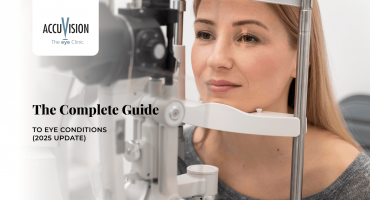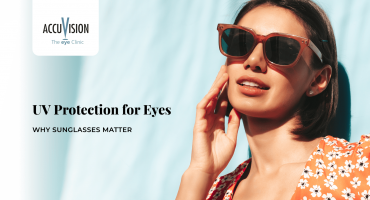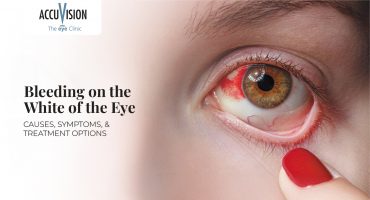- The Anterior Eye
- Why does eye pressure get high?
- Other contributing risk factors include:
- Silent Changes and Warning Signs
- Monitoring Eye Pressure
- Lifestyle and Preventive Measures for Maintaining Healthy Eye Pressure
- Conclusion
- Frequently Asked Questions (FAQs)
- References
Understanding High Eye Pressure: Causes, Symptoms and Treatments

High eye pressure, known in medical terms as ocular hypertension, arises when fluid inside the eye builds up faster than it drains. Over time, this extra pressure strains the optic nerve, increasing the risk of glaucoma and vision loss. Because ocular hypertension often has no warning signs, regular eye examinations are essential. This guide explains why eye pressure rises, how it is measured, and the treatments that protect your sight.
This article is for informational purposes only and should not replace professional medical advice. Always consult a qualified healthcare provider for diagnosis and treatment.
The Anterior Eye
Inside the anterior eye, a clear fluid called aqueous humour keeps tissues nourished and helps maintain the eye’s shape. This fluid is produced by the ciliary body, a ring of tissue just behind the iris. From there, it flows through the space between the iris and cornea and drains out through a fine, mesh-like filter called the trabecular meshwork. A smaller amount leaves via tissues in the white of the eye (the uveoscleral pathway). When production and drainage remain in harmony, intraocular pressure (IOP) remains between 10 and 24 mmHg, a range considered healthy. If drainage slows or production increases, pressure can rise above 24 mmHg, defining ocular hypertension. Above 30 mmHg, the optic nerve faces a much higher risk of damage.
Why does eye pressure get high?
Several factors can disturb the eye’s internal pressure. With age, the drainage channels may stiffen or collect debris, slowing fluid outflow. A family history of glaucoma also increases the risk for you if a direct relative has suffered with it and especially once you cross 40 years of age.
Other contributing risk factors include:
- Long-term use of corticosteroids (eye drops, inhalers, or tablets)
- Health conditions such as diabetes or thyroid disorders and some autoimmune conditions
- Previous eye injury or surgery that scars the drainage tissues
Silent Changes and Warning Signs
Ocular hypertension often develops quietly, without obvious symptoms. Most people discover raised pressure only during routine eye examinations, where tonometry tests measure IOP (intra ocular pressure).
When signs do appear, they are usually subtle and may resemble general eye strain. You might notice:
- A dull ache or heaviness behind the eyes
- Occasional blurring or mild headaches, especially after reading or screen time
- Faint rings or haloes around lights at night
- Slight redness or irritation
Since these symptoms overlap with common eye fatigue, eye pressure cannot be judged by how your eyes feel. Regular testing remains the most reliable way to detect changes early.
However, a sudden, sharp rise in pressure above 35 mmHg can cause acute angle-closure glaucoma, which is a medical emergency. It presents with:
- Intense eye pain and headache
- Nausea or vomiting
- Sudden blurred vision or bright haloes around lights
If these symptoms occur, urgent medical care is essential to prevent lasting vision loss.
Monitoring Eye Pressure
Ocular hypertension occurs when the pressure inside the eye is higher than normal, which can increase the risk of glaucoma. Detecting it involves careful evaluation by an eye care professional, who may use a combination of assessments to understand eye pressure and overall eye health.
Regular eye health examinations are important, as early detection allows timely monitoring and helps protect vision over time. Maintaining eye health through routine exams and preventative lifestyle measures can reduce the risk of long-term complications.
Lifestyle and Preventive Measures for Maintaining Healthy Eye Pressure
Moderate aerobic exercise, such as walking or swimming, may lower IOP, though inverted postures, such as some yoga poses, should be avoided. A diet rich in leafy greens, colourful fruits, and omega-3 fatty acids helps nourish the optic nerve, while evenly distributing fluid intake prevents sudden pressure spikes. Limiting caffeine intake and practising stress-reduction techniques such as deep breathing or mindfulness can help regulate systemic blood pressure, which correlates with eye pressure.
Note: Always inform every healthcare provider that you have ocular hypertension before they prescribe corticosteroids or other medications that could affect your eyes.
Conclusion
According to the American Academy of Ophthalmology, ocular hypertension and other eye conditions often develop without noticeable symptoms. That makes regular eye examinations essential, especially for adults over 40 or anyone at risk of glaucoma. Early detection and timely care can help protect vision and prevent long-term damage
Key steps for maintaining healthy eyes:
- Regular eye examinations: Every 3-6 months for diagnosed cases, annually for at-risk adults.
- Eye pressure and retinal monitoring: Detect early changes before symptoms appear.
- Personalised care plans: Tailored to your eye health, lifestyle, and medical history.
- Healthy lifestyle habits: Balanced diet, physical activity, UV protection, and screen breaks.
Modern eye clinics combine advanced imaging, precise measurements, and expert monitoring to guide treatment decisions and track progress. This structured approach ensures clarity, comfort, and confidence in managing eye health.
Early detection, preventive care, and regular monitoring remain the most effective ways to preserve clear vision throughout life.
All content is reviewed by our medical team at AccuVision to ensure reliability, but you should always consult a practitioner if you have any eye concerns or vision symptoms.
Frequently Asked Questions (FAQs)
Q1. What is the main cause of high eye pressure?
It occurs when eye fluid does not drain properly. Age, genetics, steroid use, or conditions like diabetes can increase the risk of raised pressure.
Q2. What is the best treatment for high eye pressure?
Eye drops, laser therapy (SLT), or minimally invasive surgery help lower pressure, depending on the condition. Treatment is advised by your Consultant, on a case by case basis and with regular monitoring to support.
Q3. What are the early warning signs of high eye pressure?
Most people have no symptoms. Some may notice mild eye ache, headache, or blurred vision.
Q4. How do you check if eye pressure is high?
Eye pressure is measured by tonometry during a professional eye examination.
Q5. Can high eye pressure be prevented?
Regular eye examinations, a healthy diet, exercise, and avoiding unnecessary risks can help maintain normal pressure but in most cases screening and early detection is what prevents or slows glaucomatous changes that affect the vision profoundly.
References
- American Academy of Ophthalmology. (2024, September 26). What is ocular hypertension? American Academy of Ophthalmology. https://www.aao.org/eye-health/diseases/what-is-ocular-hypertension
- Jonas, J. B., Wang, N., Wang, Y. X., You, Q. S., Yang, D., & Xu, L. (2014). Ocular hypertension: General characteristics and estimated cerebrospinal fluid pressure. The Beijing Eye Study 2011. PloS One, 9(7), e100533. https://doi.org/10.1371/journal.pone.0100533
- Machiele, R., Motlagh, M., Zeppieri, M., et al. (2025). Intraocular pressure. In StatPearls. StatPearls Publishing. https://www.ncbi.nlm.nih.gov/books/NBK532237/
- Shiose, Y. (1990). Intraocular pressure: New perspectives. Survey of Ophthalmology, 34(6), 413–435. https://doi.org/10.1016/0039-6257(90)90122-c
- Wagner, I. V., Stewart, M. W., & Dorairaj, S. K. (2022). Updates on the diagnosis and management of glaucoma. Mayo Clinic Proceedings: Innovations, Quality & Outcomes, 6(6), 618–635. https://doi.org/10.1016/j.mayocpiqo.2022.09.007
- National Institute for Health and Care Excellence (NICE). (2022, January 26). Glaucoma: Diagnosis and management (NICE Guideline NG81). https://www.nice.org.uk/guidance/ng81/chapter/recommendations
- NHS Cornwall and Isles of Scilly. (n.d.). Glaucoma. NHS Cornwall Referral Management Service. Retrieved November 3, 2025, from https://rms.cornwall.nhs.uk/rms/primary_care_clinical_referral_criteria/primary_care_clinical_referral_criteria/opthamology/glaucoma








